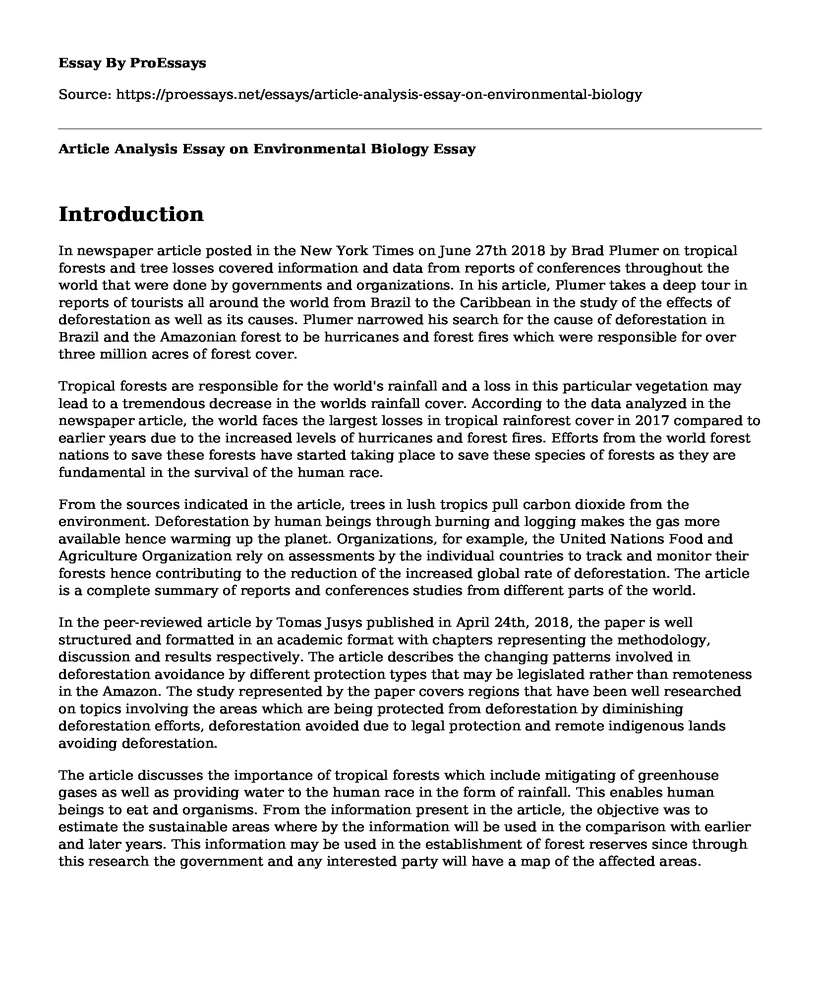Introduction
In newspaper article posted in the New York Times on June 27th 2018 by Brad Plumer on tropical forests and tree losses covered information and data from reports of conferences throughout the world that were done by governments and organizations. In his article, Plumer takes a deep tour in reports of tourists all around the world from Brazil to the Caribbean in the study of the effects of deforestation as well as its causes. Plumer narrowed his search for the cause of deforestation in Brazil and the Amazonian forest to be hurricanes and forest fires which were responsible for over three million acres of forest cover.
Tropical forests are responsible for the world's rainfall and a loss in this particular vegetation may lead to a tremendous decrease in the worlds rainfall cover. According to the data analyzed in the newspaper article, the world faces the largest losses in tropical rainforest cover in 2017 compared to earlier years due to the increased levels of hurricanes and forest fires. Efforts from the world forest nations to save these forests have started taking place to save these species of forests as they are fundamental in the survival of the human race.
From the sources indicated in the article, trees in lush tropics pull carbon dioxide from the environment. Deforestation by human beings through burning and logging makes the gas more available hence warming up the planet. Organizations, for example, the United Nations Food and Agriculture Organization rely on assessments by the individual countries to track and monitor their forests hence contributing to the reduction of the increased global rate of deforestation. The article is a complete summary of reports and conferences studies from different parts of the world.
In the peer-reviewed article by Tomas Jusys published in April 24th, 2018, the paper is well structured and formatted in an academic format with chapters representing the methodology, discussion and results respectively. The article describes the changing patterns involved in deforestation avoidance by different protection types that may be legislated rather than remoteness in the Amazon. The study represented by the paper covers regions that have been well researched on topics involving the areas which are being protected from deforestation by diminishing deforestation efforts, deforestation avoided due to legal protection and remote indigenous lands avoiding deforestation.
The article discusses the importance of tropical forests which include mitigating of greenhouse gases as well as providing water to the human race in the form of rainfall. This enables human beings to eat and organisms. From the information present in the article, the objective was to estimate the sustainable areas where by the information will be used in the comparison with earlier and later years. This information may be used in the establishment of forest reserves since through this research the government and any interested party will have a map of the affected areas.
Conclusion
The study uses materials that were previously researched while together with the authors own research on this areas. The data collected by the author on deforestation areas was done extensively with stating the limitations being separating the accessible areas from the inaccessible. The results reported that aspects of accessibility to the forest were characterized by roads with the roads attributing to 98% the deforestation experienced in these areas. The parts which deforestation in the Amazon forest was avoided was arrived at by going subtracting the unprotected areas from the protected areas. With this information, it was concluded that areas that are closer to the roads experience more deforestation. The deforested areas have also been put to active use through agriculture and settlement. The study brought to light changes in deforestation avoidance patterns which could be used in the formulation of legal protection laws.
Works Cited
Plumer, Brad. "Tropical Forests Suffered Near-Record Tree Losses In 2017." Nytimes.com. N.p., 2018. Web. 27 Sept. 2018.
"Changing Patterns in Deforestation Avoidance by Different Protection Types in the Brazilian Amazon." plos. N.p., 2018. Web. 27 Sept. 2018.
Cite this page
Article Analysis Essay on Environmental Biology. (2022, Aug 08). Retrieved from https://proessays.net/essays/article-analysis-essay-on-environmental-biology
If you are the original author of this essay and no longer wish to have it published on the ProEssays website, please click below to request its removal:
- Volcano Case Study: Mount Merapi
- Pollution Prevention Practices Essays Example
- Learning Ecological and Ethical Perspectives in Education Paper Example
- Paper Example on Tohoku Earthquake: Japan's 4th Largest Recorded Quake
- Essay Sample on Water Pollution: Impact on Human Health
- Destruction of Lake Tulare: A Historical Overview - Essay Sample
- War on Compassion: The Impact of Massification - Free Report Sample







